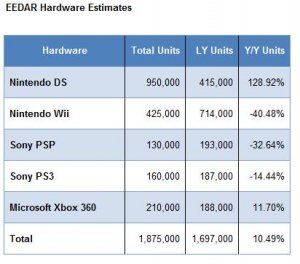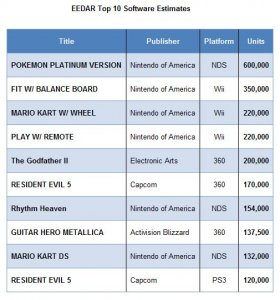Dear Reader:
EEDAR - Hardware, software sales estimates for April, full analysis
Software Sales
We expect software sales for April 2009 to come in at $548 million, a -17% decrease over last year. The decrease in sales was primarily driven by current generation home and portable software titles. Unit sales are likely to decrease by 12% from last year in conjunction with a 5% decrease in the average selling price (ASP). We believe the weak retail environment is to blame for the year-over-year decrease in ASP’s.
Our April 2009 forecast is based on a new method of regression calculations, which utilizes historical sales, consumer awareness data, and retail surveys. Previously, EEDAR’s retail sales preview used a mixture of historical regressions and light retail surveys. Unfortunately, this methodology had a flaw that allowed for a greater forecast error rate due to changes in short-term consumer spending. Our new method (which adds consumer intent and awareness data and expanded retail surveys) has allowed us to adjust our forecasts based on any changes in short-term consumer spending patterns. An example of these consumer spending changes occurred in March 2009 when software sales fell well below the expected $900M. Back testing with our new methodology, we would have forecasted March 2009 sales at $830M (compared to $793 actual).
April Sales and the State of the Industry
We believe that April’s low sales are mostly the result of a weaker release schedule and is not likely an indication that the industry is contracting. If April sales exceed $550M, we believe it is a positive sign for the industry and an indication that sales may remain robust for the rest of the calendar year. Sales below $510M would be an indication that consumer spending in the video game sector is beginning to contract over last year and could impact sales in the summer months. Based upon March sales, EEDAR has lowered its calendar year software sales growth from 10% to 7%.
Our April forecast would put year-to-date growth at -5%. Not since 2001 has software sales declined by more than 5% from the January to April months. The previous January to April decline occurred in 2006 at about 3%, but the full-year still posted mid-single digit growth.
Hardware Sales
We expect hardware unit sales for the next-generation systems to increase by 10% over last year. This was entirely driven by the Nintendo DS, with its DSi release, which is expected to post year-over-year growth above 129%. The Xbox 360 is expected to post mild growth with the rest of the consoles posting negative unit growth.
Quick Facts:
· April 2009 is expected to have 21 titles exceed 100,000 units compared to over 11 last year.
· No titles are expected to sell over 1 million units (combined multi-platform) compared to 2 last year.
· The top ten for April 2009 is expected to sell 2.3 million units combined compared to over 5.3M units last year.
· February 2006 was the last time our industry posted two negative comp months in a row.
· Without the DSi, hardware sales would have likely been down by over 27%.
Rhythm Heaven and the Use of Celebrities
Rhythm Heaven is a fairly standard game in terms of features, but its sales performance has been nothing short of amazing due to Nintendo’s ability to leverage an effective marketing campaign using a celebrity (Beyonce).
Rhythm Heaven is one of the few games in our industry where the marketing budget—expected to exceed $6 million worldwide—is likely larger than the cost of development. With video games now becoming a mass-market entertainment product, publishers must realize that to truly reach the mass-market audience, they must use mass-market techniques (such as celebrity endorsement) to market their products. Rhythm Heaven’s marketing campaign is no different than how other companies have used celebrities to gain market awareness, such as Michael Jordan and Nike; Ozzy Osbourne and World of Warcraft; Michael Jackson and Pepsi; and of course the long-list of celebrities in the “Got Milk” campaign.
In this new gaming market, when targeting a mass-audience, it is not always the best products that succeed, but often what the consumers believe is the best product. Using celebrities in a mass-market media campaign is certainly one of the most effective ways to create the perception of being a must-own title. In fact, the Guitar Hero/Rock Band war is a perfect example of how Guitar Hero was ultimately able to gain mass-market acceptance through celebrity endorsements and advertisement even though editorial reviews indicated that Rock Band was a better product.
Music Category to get a Boost in April, but for the Wrong Reasons
We expect the Music & Rhythm category to get a small boost in sales in April due to massive retail discounting. With most music bundle packages being an awkward size, retailers had to improvise last holiday season to ensure proper product placement in their video game departments. With the holidays long-over and the Music & Rhythm genre declining in sales, retailers have grown impatient with the large amount of back-inventory. With the likely approval from Activision, most major retailers had widespread discount sales on Guitar Hero products including Amazon, Toys R Us, GameStop, Best Buy, and Wal-Mart. The biggest sales occurred at Wal-Mart.com with certain Guitar Hero World Tour SKUs being discounted by as much as $90 and Best Buy with a sale that gave away Guitar Hero: Aerosmith for free with the purchase of Guitar Hero: Metallica.
While these sales certainly drove revenue and increased the Guitar Hero / Rock Band hardware install base, these wide discounts are a good indication that going forward retailers plan to only carry a minimal amount of inventory on Guitar Hero and Rock Band hardware, which is a sign that sales are beginning to fizzle. Fortunately, both Activision and MTV plan to leverage their product’s brand names and target other market segments by releasing titles such as DJ Hero and Lego Rock Band, both of which are expected to expand the reach of the Music & Rhythm category rather than overload the current Music & Rhythm channel.
For the calendar year we expect the Music & Rhythm category to be down 15% compared to a market and publisher consensus of “flattish” comps. To date the Music & Rhythm category is down over 30%.
PR email

